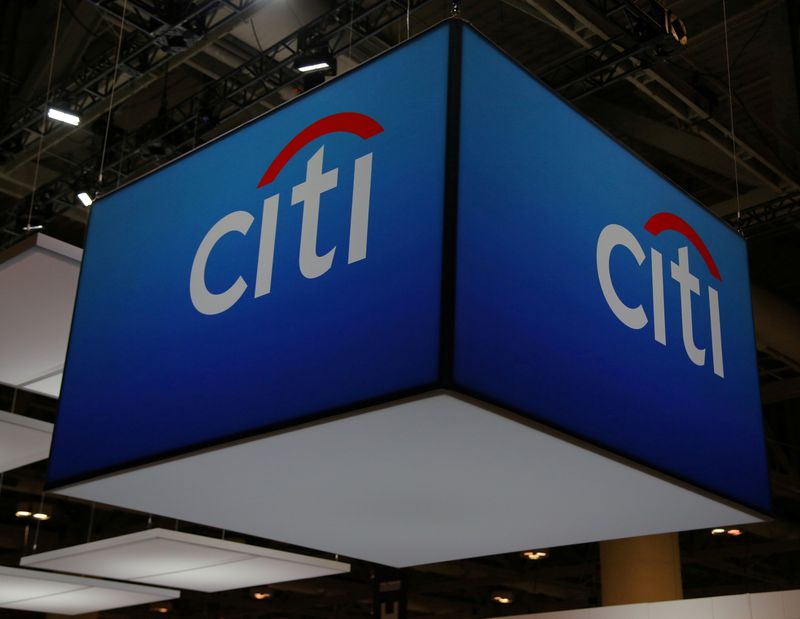US bank giants ride rate rises, keep storm clouds at bay
2023.04.15 07:42

© Reuters. FILE PHOTO: The Citigroup Inc (Citi) logo is seen at the SIBOS banking and financial conference in Toronto, Ontario, Canada October 19, 2017. Picture taken October 19, 2017. REUTERS/Chris Helgren
2/2
By Nupur Anand, Tatiana Bautzer and Saeed Azhar
NEW YORK (Reuters) -U.S. banking heavyweights reaped windfalls from higher interest payments in the first quarter, brushing off a crisis prompted by the collapse of two regional lenders and setting aside billions of dollars in case loans turn sour as the economic outlook dims.
First-quarter 2023 earnings from JPMorgan Chase & Co (NYSE:), Citigroup Inc (NYSE:) and Wells Fargo (NYSE:) & Co beat Wall Street expectations on Friday as consumer and corporate spending held up in the face of rate rises, although all three saw signs of a slowdown and made provisions accordingly.
“Goliath is Winning,” Wells Fargo analyst Mike Mayo said in a note citing a “uniquely strong quarter” for JPMorgan, calling it “a port in the storm” during recent banking sector tumult.
JPMorgan shares soared 7.6% in their biggest one-day percentage gain since November 2020.
Banks are building up rainy day funds as fears of an economic slowdown mount from the U.S. Federal Reserve’s aggressive interest rate hikes to tame inflation as well as the recent turmoil fueled by the failures of two mid-sized banks.
JPMorgan CEO Jamie Dimon warned that while the U.S. economy remains robust, last month’s banking crisis with the sudden collapse of Silicon Valley Bank (SVB) and Signature Bank (OTC:) could make lenders more conservative and hurt consumer spending.
“The storm clouds that we have been monitoring for the past year remain on the horizon, and the banking industry turmoil adds to these risks,” Dimon said.
Citigroup, which also beat Wall Street expectations as it earned more from borrowers paying higher interest on loans, said it was prepared for a mild recession in the U.S.
“It’s now more likely that the U.S. will enter into a shallow recession later this year,” Citigroup CEO Jane Fraser told analysts on a conference call. “That could be exacerbated in depth and duration in a more severe credit crunch.”
Still, she said “the biggest unknown” was the impact of U.S. interest rates and how talks in Washington on the U.S. debt ceiling play out.
Shares of several banks surged after the results, and the bank index closed up 3.5%. Citigroup surged 4.8%. Wells Fargo investors were less impressed, pushing its shares down 0.05%.
Regional banks shares dragged on the index with its biggest losers, Zions Bancorp and First Republic Bank (NYSE:) , both falling more than 3%. After falling sharply earlier in the day PNC Financial Services Group (NYSE:), which reported an 18.5% rise in first-quarter profit, managed to eke out a 0.36% gain.
The KBW regional bank index finished down 2.2%.
One area where it has proven harder for the big banks to profit in 2023 has been investment banking, which was reflected in JPMorgan’s business with a 24% fall in revenue at the unit as dealmaking dries up in the face of high interest rates, inflation and fears of a recession.
TROUBLE AHEAD?
JPMorgan beat market expectations with a 52% rise in profit to $12.62 billion, or $4.10 per share, in the three months to the end of March, while its loan loss provisions increased by 56% from last year to $2.3 billion. Net interest income, a measure of how much a bank earns from lending, surged 49%.
The bank also reported a surge in deposits in the first quarter, as fears over the health of regional lenders drove customers to move their money to bigger banks.
Citigroup set aside $241 million to cover potential loan losses compared to a reserve release of $138 million a year ago.
Wells Fargo set aside $1.21 billion in the quarter to cover potential loan losses, compared to a release of $787 million a year earlier.
Wells Fargo said its provision included a $643 million rise in the allowance for credit losses, reflecting an increase for commercial real estate lending, primarily office loans, as well as an increase for credit card and auto loans.
“While most consumers remain resilient, we’ve seen some consumer financial health trends gradually weakening from a year ago,” Mike Santomassimo, Wells Fargo finance chief, told analysts. The company is taking action “to position the portfolio for a slowing economy,” he said.
In another key part of the financial services sector, BlackRock Inc (NYSE:) – the world’s largest asset manager – reported an 18% drop in first-quarter profit but beat analysts’ estimates as investors continued to pour money into its funds, cushioning the hit to fee income from the banking rout that rocked global markets.
More banking results are due over the coming week, including Bank of America (NYSE:) and Goldman Sachs (NYSE:) on Tuesday and Morgan Stanley (NYSE:) on Wednesday.
Investors are also anxiously awaiting reports from several regional banks – the hardest-hit group during the banking tumult last month – for more clarity on the outlook ahead for them.
Financial broker Charles Schwab (NYSE:) is expected to report a rise in revenue when it announces results on Monday, followed by Western Alliance (NYSE:) Bancorp on Tuesday.
Zions reports on Wednesday.
First Republic, which was shored up by a group of 11 lenders that injected $30 billion into it after its shares plunged during the crisis last month, is due to report results on April 24.








